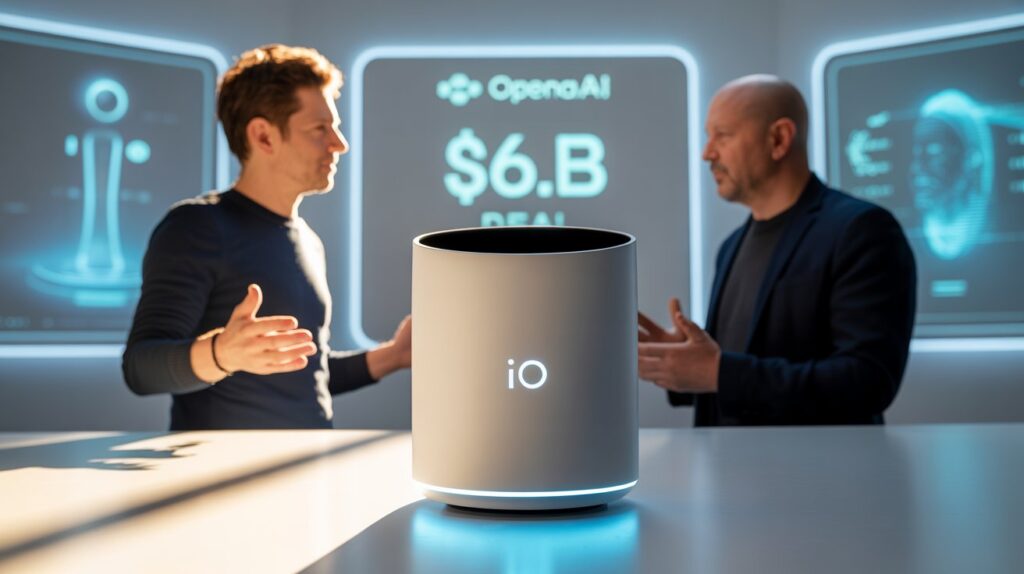OpenAI Acquired AI Hardware Startup ‘io’ for $6.5 Billion: A Game-Changer in AI Consumer Products
Introduction: A New Era for AI Consumer Products
In a bold move that signals its intent to dominate both software and hardware, OpenAI has acquired AI hardware startup ‘io’ in a $6.5 billion stock deal. Co-founded by legendary Apple designer Sir Jony Ive, io is now set to become a crucial component of OpenAI’s push into AI-powered consumer devices. With this acquisition, OpenAI aims to revolutionize the way humans interact with technology.
This development marks one of the most significant AI hardware acquisitions in recent history and sets the stage for the release of innovative AI-integrated devices expected to launch in 2026.
The Vision Behind OpenAI’s Acquisition of io
OpenAI hardware acquisition isn’t just a financial transaction—it’s a strategic alignment of visionary minds. Sam Altman, CEO of OpenAI, and Jony Ive, former Chief Design Officer at Apple, have been collaborating for over two years to bring an entirely new form of AI hardware experience to life.
Their mission? To reimagine consumer electronics using AI. Instead of enhancing current tech like smartphones or smart speakers, they want to create a brand-new device—one that blends contextual intelligence, voice interaction, and environmental awareness. In short, a Jony Ive AI device built from the ground up for the AI-first future.
Deal Highlights: $6.5 Billion and a Design Powerhouse
The $6.5 billion OpenAI hardware acquisition involves $5 billion in stock and includes the integration of roughly 55 employees from io into OpenAI. These staff members will now form a dedicated AI hardware division. Meanwhile, Ive’s world-renowned design firm, LoveFrom, will continue to lead the creative vision across both OpenAI and io.
This move doesn’t just bring in design talent—it empowers OpenAI with an end-to-end product development capability, from silicon to software to design.
What Is the AI Device Launching in 2026?
Although OpenAI hasn’t revealed detailed specifications, insiders suggest that the first OpenAI AI device 2026 will be screenless or include minimal UI, focusing instead on natural language interaction, advanced AI processing, and possibly even spatial awareness.
Imagine a world where your device knows where you are, what you’re doing, and how to help—without you needing to touch a screen. That’s the future Jony Ive and Sam Altman are crafting.
Expected Features:
-
AI-first design without dependency on a screen
-
Seamless voice-activated commands and feedback
-
Contextual learning powered by OpenAI’s models
-
Privacy-focused hardware with edge AI capabilities
-
Premium, minimalist industrial design (thanks to Ive)
This is not a smartphone alternative—it’s an entirely new category of AI consumer products.
Why This Acquisition Matters for the Tech Industry
This acquisition is about more than just launching a device. It reflects OpenAI’s ambition to challenge Apple, Google, and Amazon in the consumer device market.
With OpenAI’s massive success in software—thanks to ChatGPT, DALL·E, and Codex—the move to hardware is the next logical step. The AI hardware startup io provides the design DNA and product vision OpenAI needs to build devices that make AI more intuitive, ambient, and human-friendly.
Strategic Implications:
-
Vertical integration of AI models and hardware
-
Stronger control over the AI user experience
-
Enhanced trust through OpenAI-designed secure devices
-
Competitive edge over AI assistants limited by third-party platforms
The Role of Jony Ive in Shaping OpenAI’s Future
Few designers have had as much influence as Jony Ive, who was instrumental in creating the iPhone, iPad, and MacBook designs at Apple. Now, with his new role in AI product design, he is positioned to help OpenAI craft devices that feel both futuristic and familiar.
His minimalist approach to product design aligns perfectly with OpenAI’s philosophy of natural, unobtrusive interaction. The combination of cutting-edge AI and iconic design may well define the next generation of personal tech.
Timeline: What’s Next for OpenAI’s AI Devices?
| Milestone | Details |
|---|---|
| Q2 2025 | Acquisition of io finalized |
| Q3 2025 | Internal R&D and prototyping begins |
| Q1 2026 | Possible product teasers or beta trials |
| Q3/Q4 2026 | First AI-integrated consumer device launch |
This timeline could shift, but industry analysts expect OpenAI to make major announcements by mid-2026.
Conclusion: OpenAI’s Next Chapter Is Hardware—And It’s Just Beginning
The $6.5 billion OpenAI hardware acquisition of io is more than just a tech merger—it’s the birth of a new category of AI-first devices. With design genius Jony Ive at the helm and the deep-learning capabilities of OpenAI’s models, we are entering an age where devices will understand and assist us in ways that feel truly human.
For tech enthusiasts, developers, and AI futurists, 2026 is shaping up to be a landmark year. Keep an eye out—because the Jony Ive AI device might be the first step in the evolution from smartphones to smart companions.
FAQs About OpenAI’s Acquisition of io
1. What is io, the AI startup acquired by OpenAI?
io is an AI hardware startup co-founded by Sir Jony Ive. It focuses on building AI-first devices that go beyond traditional screens and interfaces.
2. How much did OpenAI pay for io?
OpenAI paid $6.5 billion in an all-stock deal, with $5 billion in newly issued shares.
3. When will OpenAI launch its first AI device?
The first AI-integrated product from OpenAI and io is expected to launch in 2026.
4. Who is Jony Ive, and what is his role?
Jony Ive is a legendary designer known for his work at Apple. He co-founded io and will lead the design of OpenAI’s future devices through his firm LoveFrom.
5. What is the goal of this acquisition?
To create a new category of AI consumer products that offer intuitive, ambient interaction and redefine personal technology.
6. Will this device replace smartphones?
Not necessarily. It aims to be a complementary AI-native device rather than a direct smartphone competitor.

